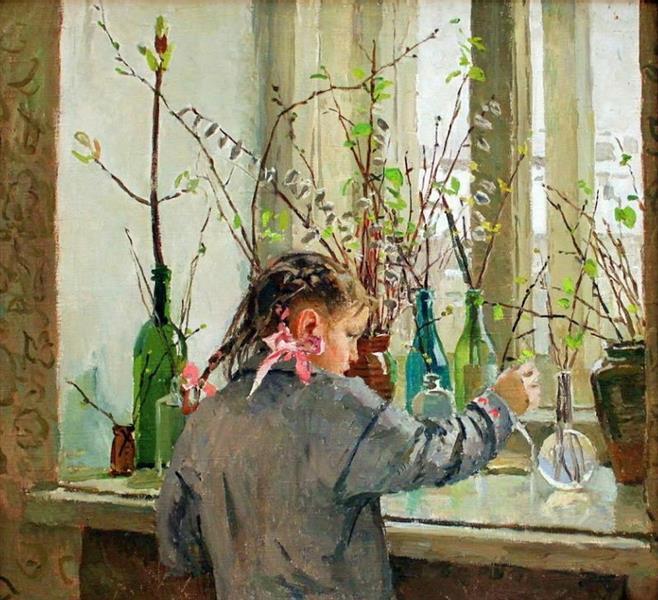Only yesterday did I realize that one of my favorite “Russian” artists was Ukrainian. While Tatiana Yablonska died at age 88 in Kyiv (Kiev) after an illustrious career, her birthplace was Smolensk, an ancient city founded in the 11th century during the period known as “Kieven Rus.” Smolensk’s history has witnessed many periods of brilliance as well as tragic invasions by the armies of Napoleon and Hitler.
Smolensk has special meaning in our family. Tucked today into the western edge of the Russian Federation, it serves as the capital of a region that includes the birth village and orphanages of our two children. Hence, Smolensk was the administrative point where we concluded their adoptions back in 1996 and 1999. Consequently, Hank and I twice had the experience of pacing through Smolensk’s leafy parks, awaiting the completion of paperwork while anxiously tracking the waning hours before our scheduled night train back to Moscow. At the time I would neither have known, nor cared, whether Yablonska’s paintings were hanging nearby where we walked.
Yablonska was one of dozens of artists I discovered upon first exploring Leningrad’s fabulous Russian Museum in 1981. The 20th-century artists celebrated in that gallery had no choice but to become masters of representational art, capable of doing a delicate dance between modern styles and a curious, oppressive doctrine called Socialist Realism, wherein artists in every branch of the Fine Arts had to create works that bespoke an idealized “folk” engaged in positive actions.
Today, much of that Socialist Realist art is being reexamined and admired anew, not only for how skillfully the artists “threaded the needle,” so to speak, but for how marvelously and cleverly they captured the essence of those folk, particularly in times that were dark and foreboding.
In 1981, I would have accepted the designation of artists as Russian who, in fact, were ethnically Ukrainian or Byelorussian. Furthermore, while no one hid the information that significant artists like Bortniansky, Gogol, and Repin were Ukrainian, I never thought of them as such. Everything was produced under the aegis of the Soviet Union, after all. Furthermore, the history of close, if distrustful, relations between Ukraine and Russia tended to blur this fact . . . at least for Russians. But not for Ukrainians.

All of this comes up because of two reasons. First, the heart-rending “current events” we are watching do not leave my mind. Secondly, now is precisely the time of year when the action depicted in Yablonska’s canvas entitled Spring on the Window Sill (1954) occurs. We see a little girl doing something common for children, especially those living in Northern climes. With winter’s harshness lingering, the desire to see something bud with greenery grows strong. Hence, a tradition has arisen where, several weeks before Easter, children (and adults) cut branches, place them in water, and let them ripen and bud, making a window garden.
If timed right, the verdure emerges in what we would call “Holy Week” in the West—just in time for Easter. Those colorful patterned Palekh Easter Eggs would, by tradition, be hung on these branches, and the window garden would become a beautiful symbol of Christ’s Resurrection.
Today I think of the countless children who trustingly placed their twigs in vases mere days before the invasion of Ukraine on February 24. Those living in towns tragically destroyed like Mariupol may no longer be alive, their precious window “forests” crushed beneath shattered walls and splintered roofs.
Or they may be huddled with their mothers, grandmothers, and siblings in make-shift bomb shelters or scattered in refugee way-stations as far away as Germany or beyond. They will not awake to see green buds peeking from twigs filling their kitchen windows, shyly announcing that Easter is near.
Paintings capture moments. They snatch intangible truths from air and fashion them into a two-dimensional form dependent on the illusion of depth, the energy of line, and hidden sources of light. Where a painter is born may matter, or it may not. What is placed in that painter’s heart as a child always matters. And so, as we watch and wait to see the course of history, let me commend Yablonska’s precious canvas to you.




Honestly, nothing I have read about the “current event” has moved me in the same way this has. The show of hope that is the creating of a window garden, and then that hope taken and all that represents…what a beautiful, heart-aching piece you’ve written. Thank you.
Moving and timely. Should be required reading for all those Russian citizens who only know what their government tells them.
This is beautifully written. Thank you for putting context to this lovely painting, and using it to make this whole terrible war more real.